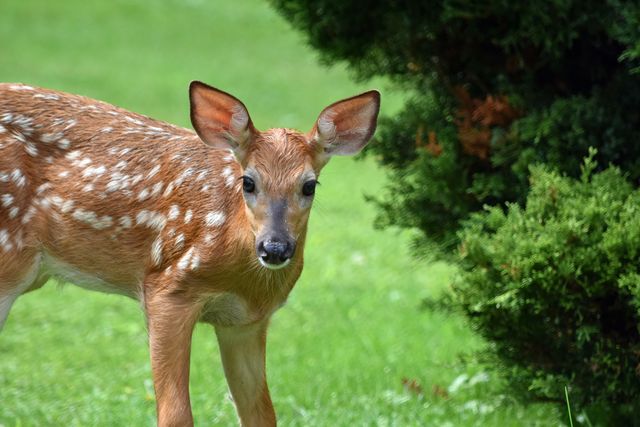All gardeners in the history of gardening know the challenge of deer control. I can still hear my mom whipping open the sliding door and clapping her hands to scare them away from our tomatoes. There’s no denying it: Deer find your raised beds full of vegetables just as tasty as you do — and your roses, geraniums, and daisies happen to be the perfect dessert.
But instead of spraying chemicals on your garden, try one of these other DIY ways to gently discourage deer, and maybe even bunnies and mosquitos, too. Keep in mind though that these critters learn quickly, so try rotating a few different methods for best results.
Add these plants.
This spring, consider surrounding your garden with a thick layer of plants that have a strong aroma, like lavender or marigolds. “Deer are reluctant to walk through lavender as the smell stays on their legs making it hard for them to sense predators,” says gardener Sally Morgan. “And the unusual smell also interferes with their ability to find food and assess their environment.”
Similarly, Lisa Orbin, a gardener of 10 years, explains that deer dislike the astringent smell marigolds gives off. “Basically, they don’t smell good enough to eat,” she says. You don’t have to go crazy, but the more plants, the better (and the prettier). In addition to circling your garden, try potting a few plants to sprinkle around your yard. Feel free to mix in other fragrant herbs, like mint, oregano, or catnip as well.
Sprinkle some soap.
Every spring growing up, I’d watch my mom cube bright green Irish Spring Original soap and skewer it into the ground around new plants. She’d adjust the height of each wooden skewer to just above the budding plants, deterring deer from munching, and allowing early plants to mature. Sometimes, she’d use a long-grain grater and shave the soap around seedlings before they appeared.
“The best part, is soap lasts for about a month,” she explains. “It only disintegrates when it rains, doesn’t affect plants, and also helps dehydrate any aphids or bugs that may be lurking in the soil.”
The tallow in the soap helps keep deer away, according to the University of Vermont Extension Department of Plant and Soil Science, so you don't have to go with Irish Spring. Many highly fragrant kind can help keep your flowers from becoming deer candy, but steer clear of bars containing coconut oil, which may actually attract them.
Make this invisible fence.
Maybe the most obvious way to manage deer is to fence off your garden. But you don’t have to be a carpenter or compromise the beauty of your plot. Horticulturist and plant expert Gene Lorainne uses just a few rows of clear fishing wire to keep the deer away from her garden.
She stakes the perimeter of the garden with a tall piece of wood (about 5 feet high), then starting 2 to 3 inches from the ground she strings a row of fishing line. She repeats this three more times, placing the rows of fishing wire about a foot apart.
The result: a tall, almost-invisible fence. “The deer can’t see the cords, so they won’t attempt to jump over either,” says Lorainne. This way, you can keep them out and still gaze at your pretty little patch of heaven.
Spray something smelly.
Another way to deter deer from munching on your garden is spraying an unappealing scent. Garden hobbyist Mary R. has been making this homemade (rather stinky) spray that helps keep deer out of her garden for over 15 years.
In a gallon jug, she mixes 1 cup of milk, 1 egg, and 1 tablespoon of dish soap and fills the rest with water. She keeps the gallons out in the sun during the day to get the aroma flowing before she sprays.
“I spray most nights, so I’m not in the yard when it smells the worst,” she says. It’s not harmful to plants and it also keeps ground critters from her yard. Consider mixing in some cut up hot peppers for extra deer-deterring power.
Make some noise.
“By simulating unexpected sights and sounds, you are triggering the deer’s main defense against prey,” says Dr. Leonard Perry, a professor at the University of Vermont’s Department of Plant and Soil. For instance, by stringing up CDs around your garden, you’re creating a motion that deer are not used to, and they will spook.
Another effective visual is creating a white flag about 10 inches long and five inches wide that resembles a white deer tail. “They see this ‘tail’ move, but no deer, and they often get spooked and flee,” he says.
Hanging up pie tins and aluminum cans creates both an unusual visual and sound. “Some gardeners swear by talk radio,” adds Perry, which is another sound tactic you may try. For these to work, it’s crucial to rotate which method of spookiness you use around your garden or the deer will get used to it and continue nibbling on your plants.















